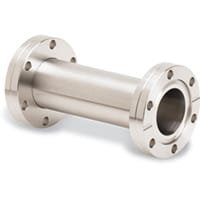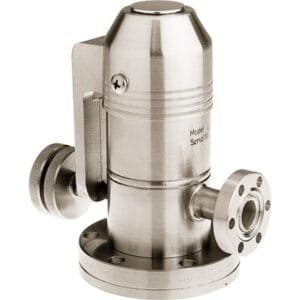ConFlat (CF) UHV Full Nipples: Reliable Connections for Ultra-High Vacuum Systems
ConFlat (CF) UHV Full Nipples are essential components in ultra-high vacuum (UHV) systems, designed to provide secure, leak-tight connections between various vacuum components. Crafted from 304L stainless steel, these nipples are highly resistant to corrosion and feature ConFlat (CF) knife-edge flanges, ensuring a reliable seal that meets the stringent requirements of high-vacuum environments.
At TFM, we specialize in manufacturing CF UHV Full Nipples that deliver exceptional performance and durability, even in the most demanding UHV applications.
What Are ConFlat (CF) UHV Full Nipples?
ConFlat (CF) UHV Full Nipples are straight, cylindrical connectors designed to join two vacuum components in a UHV system. The full nipple design provides an extended length, allowing for more flexibility in system configurations and easier alignment of components. These nipples are equipped with CF flanges on both ends, creating secure, leak-tight connections that are essential for maintaining the integrity of the vacuum system.
The 304L stainless steel construction ensures that these nipples are highly durable, resistant to corrosion, and suitable for long-term use in UHV systems. Additionally, the ConFlat flanges create a reliable seal, which is crucial in maintaining the high vacuum levels necessary for various industrial and research applications.
Key Features of ConFlat (CF) UHV Full Nipples
1. 304L Stainless Steel Construction
Each CF UHV Full Nipple is made from high-quality 304L stainless steel, which offers superior strength, corrosion resistance, and minimal outgassing. This makes it ideal for use in UHV systems where cleanliness and stability are critical.
2. ConFlat Flanges for Leak-Tight Seals
The CF flanges on both ends of the nipple provide a knife-edge seal when paired with compatible gaskets, ensuring that your vacuum system maintains a strong, leak-free seal under demanding conditions. This is crucial for applications that require stable and consistent vacuum levels.
3. Extended Length for Flexible Integration
The full nipple design offers an extended length, which allows for more flexible and adaptable integration into complex UHV system configurations. It makes connecting two components easier, particularly when there is a need for more space between them.
4. Durable and Vibration-Resistant
The 304L stainless steel material ensures that the nipples are not only durable but also resistant to vibration and mechanical stress. This durability is essential for maintaining the integrity of the system in dynamic environments where mechanical vibrations may occur.
5. Versatile Compatibility
ConFlat (CF) UHV Full Nipples are compatible with a wide range of ConFlat-flanged components, such as valves, flanges, and chambers, providing seamless integration into various UHV setups. Their flexibility makes them ideal for applications across industries such as semiconductor manufacturing, research, and aerospace.
Applications of ConFlat (CF) UHV Full Nipples
These CF UHV Full Nipples are commonly used in industries and research fields where high vacuum or ultra-high vacuum systems are required. Some of the key applications include:
Semiconductor Manufacturing: Essential in cleanroom environments and production lines where precise vacuum control is needed for semiconductor processing, etching, and deposition.
Research Laboratories: Used in physics and material science research, particularly in experiments that require a controlled vacuum environment, such as particle accelerators and spectroscopy chambers.
Aerospace and Space Simulation: In space simulation chambers and testing facilities, CF UHV Full Nipples are used to connect various UHV components, enabling the replication of space conditions.
Thin Film Deposition: These nipples play a vital role in systems for thin film deposition, ensuring that vacuum lines are properly connected and maintained to guarantee accurate and consistent coating processes.
Vacuum Furnace Systems: In industries that require high temperatures and low pressures for material heat treatments, CF UHV Full Nipples provide secure, leak-tight connections for the vacuum lines in furnace systems.
Why Choose TFM’s ConFlat (CF) UHV Full Nipples?
At TFM, we are committed to providing high-quality, durable components designed to meet the demanding needs of UHV systems. Here’s why you should choose our CF UHV Full Nipples:
Premium Quality Materials: Our nipples are made from 304L stainless steel, offering excellent resistance to corrosion, high tensile strength, and minimal outgassing, making them ideal for UHV applications.
Reliable Leak-Tight Seals: The ConFlat flanges ensure a secure and leak-tight seal, maintaining the vacuum integrity of your system and providing reliable performance over time.
Flexible Integration: With their extended length, our CF UHV Full Nipples provide more flexible installation options, helping you adapt to various UHV system configurations.
Vibration and Mechanical Stress Resistance: Designed to withstand vibrations and stresses, our nipples ensure that your system stays intact, even in dynamic environments.
Expert Support and Custom Solutions: We offer tailored solutions to meet your specific requirements and provide expert guidance on selecting the right components for your system.





Reviews
There are no reviews yet.